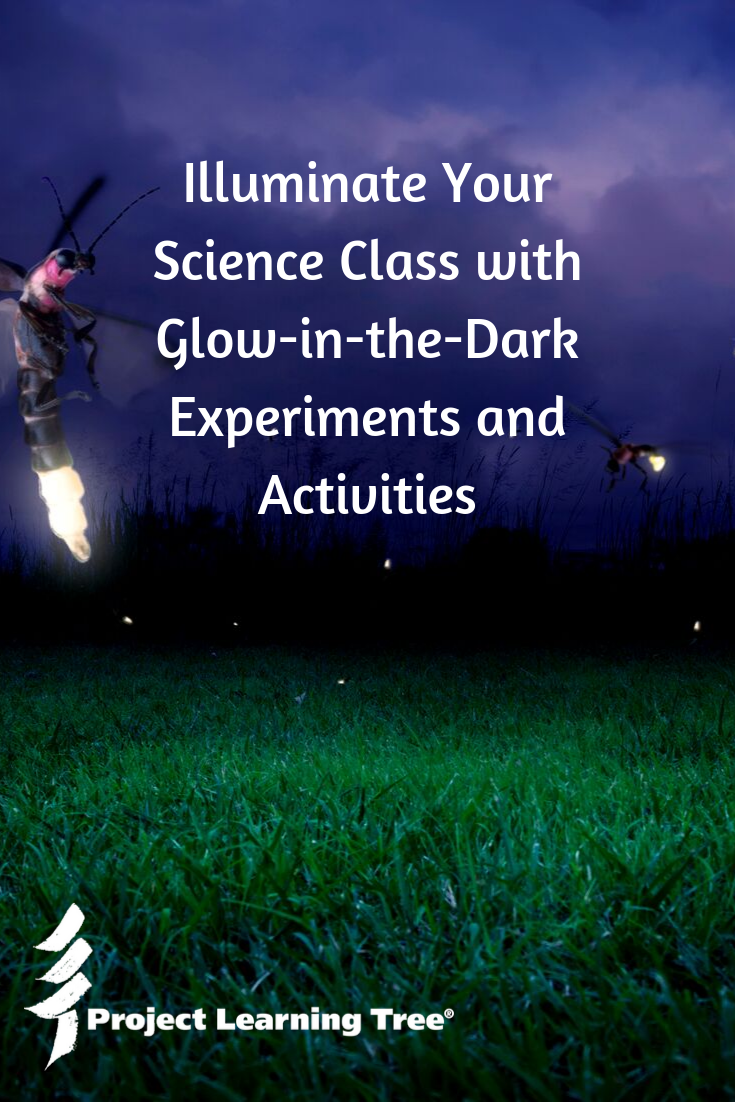 As the days become shorter and night sets in sooner, we turn to electricity to extend our days. And we’re not the only species that have found a way to generate light – there are some animals, insects, and organisms that have evolved to produce light for various reasons. Glowing in the dark is a fun topic to explore with students this season, whether it’s centered around the changing seasons and the darkness that comes with winter, or if you’re simply looking for glow-in-the-dark experiments and activities for a Halloween-themed lesson.
As the days become shorter and night sets in sooner, we turn to electricity to extend our days. And we’re not the only species that have found a way to generate light – there are some animals, insects, and organisms that have evolved to produce light for various reasons. Glowing in the dark is a fun topic to explore with students this season, whether it’s centered around the changing seasons and the darkness that comes with winter, or if you’re simply looking for glow-in-the-dark experiments and activities for a Halloween-themed lesson.
Bioluminescence stands out as one of the most amazing adaptations to grace our planet. By creating their own light through chemical reactions, these critters inspire curiosity in learners of all levels. Fireflies are the most common bioluminescent creatures in North America, lighting up the summer nighttime sky to find a mate. If you travel to the Great Smoky Mountains in June, you may catch sight of the synchronized fireflies flashing together at the same time.
Other invertebrates, such as California’s Motyzia millipede, give off a greenish-blue light as a warning to predators of their cyanide poisoning. Glowworms in New Zealand use their glow attract prey in the caves in which they inhabit. Ocean-inhabiting creatures such as dinoflagellates, glowing jellyfish, and anglerfish have also developed uses for bioluminescence. Benjamin Franklin suggested using glowing mushrooms, such as foxfire, to illuminate one of the first submarines. These organisms have fascinating ways to use their unique gift of luminescence.
Capture your students’ curiosity and love of learning by using bioluminescence as a springboard into the world of luminescence. There are many ways of adapting glow-in-the-dark lessons to a variety of subjects and grade levels. Spark your class’s attention by introducing them to the fascinating organisms that can create their own light. Continue the excitement with these hands-on activities that will deepen their understanding of biology and chemistry.
Glow-in-the-Dark Experiments and Activities for Elementary Students
Oil and water experiment
Teach young learners about hydrophobic and hydrophilic solutions with a unique twist. By using glow in the dark oil instead of regular vegetable oil, learners will clearly see that some materials stay separated in mixtures. This glowing oil and water experiment uses simple ingredients and blacklights to reinforce the resistance of oil and water mixing.
Glow-in-the-dark art projects
Glowing foam paint is a fabulous STEAM lesson uses shaving cream, school glue, and neon paint to create puffy, three-dimensional paint that glows in the presence of blacklight. This lesson can be used to discuss mixtures and states of matter.
Luminescent baking soda and vinegar volcano
Update your ordinary baking soda and vinegar volcano demonstration by adding some luminescence. Try this glow-in-the-dark volcano that uses ink from a highlighter or glow sticks.
Chemical reaction experiment with glowsticks
Investigate the effects of temperature on glowsticks with the temperature and the rate of a chemical reaction experiment from the American Chemistry Society. Check out more experiments on their site here.
Glowsticks and temperature experiment
Light sticks – liquid light, from Steve Spangler Science, provides step by step instructions for using light sticks to observe the differences in brightness of the light given off from glowsticks placed in water of different temperatures.
A lesson on density
Use oil, water, and neon watercolor paint to enhance lessons on density. Students will quickly see fluids of three different densities separate in the mixture. Glowing fireworks in a jar is an activity that they will remember for many years to come.
Glow-in-the-Dark Experiments and Activities for Middle School and High School Students
Investigating dinoflagellates
Marine dinoflagellates are responsible for producing beautiful, blue, glowing waves. Investigating glow-in-the-dark dinoflagellates allows students to observe their bioluminescence at home or at school as well as conduct experiments on the factors that affect bioluminescence.
Experiments with glow-in-the-dark water
Explore glow-in-the-dark water using tonic water and blacklights. Experiment with the glow in the dark water to determine if the addition of household chemicals affects the glow.
Exploring luminescence
In illuminating luminescence, from Science Friday, students will compare and contrast different forms of luminescence by observing how chemiluminescence, phosphorescence, and fluorescence produce or emit light. Students then compare these forms of luminescence to bioluminescence.
Glowing crystals
Growing alum crystals is very easy and reliable way to demonstrate the process of crystallization. Convert this ordinary experiment into something spectacular by making glowing crystals, which uses the ink from a yellow highlighter, you can. After the crystal forms, simply shine a black light on the crystal to make it glow.
Glowing flowers
Discuss vascular tissue in plants while making a glowing flower. Instead of soaking the plant in ordinary water, use water that contains ink from a highlighter.
Create your own glow-in-the-dark milk plastic
Teach students about plastics and proteins in milk by making glow-in-the-dark milk plastic.
Check out more glow-in-the-dark experiments and activities on our Pinterest page. Which ones will you try with your students this fall?


